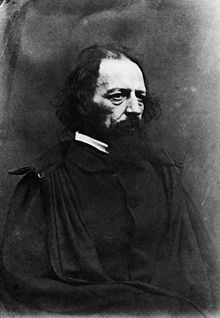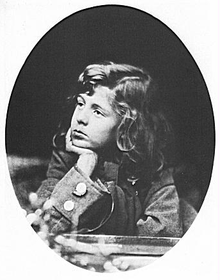- Oscar Gustave Rejlander
-
 Oscar Rejlander
Oscar Rejlander
Oscar Gustave Rejlander (Sweden, 1813 – Clapham, London, 18 January 1875) was a pioneering Victorian art photographer and an expert in photomontage. His collaboration with Charles Darwin on The Expression of the Emotions in Man and Animals has assured him a position in the history of behavioural science and psychiatry.
Biography
His exact date of birth is uncertain, but was probably 1813. He was the son of Carl Gustaf Rejlander, a stonemason and Swedish Army Officer. He studied art in Rome where he saw photographs of the sights, and then initially settled in Lincoln, England. He abandoned his original profession as a painter and portrait miniaturist, apparently after seeing how well a photograph captured the fold of a sleeve. Other accounts say he was inspired by one of Fox Talbot's assistants.
He set up as a portraitist in the industrial Midlands town of Wolverhampton, probably around 1846. Around 1850 he learned the wet-collodion and waxed-paper processes at great speed with Nicholas Henneman in London, and then changed his business to that of a photography studio. He undertook genre work and portraiture. He also created erotic work, using as models the circus girls of Mme Wharton, street children and child prostitutes - his Charlotte Baker series remains notorious.
Rejlander undertook many experiments to perfect his photography, including combination printing from around 1853, which it is possible he may have invented. He had articles feature in the Wolverhampton Chronicle, on the 15th November 1854 an article called "Improvement in Calotypes, by Mr. O.G. Rejlander, of Wolverhampton" it suggests that by 1854 he was experimenting with combination printing from several negatives. He was a friend of photographer Charles Lutwidge Dodgson (better know by the nom de plume Lewis Carroll), who collected Rejlander's early child work and corresponded with him on technical matters. Rejlander later created one of the best known & most revealing portraits of Dodgson.
His early work only slightly sullied his later reputation, and he participated in the Paris Exhibition of 1855. In 1857 he made his best-known allegorical work, The Two Ways of Life. This was a seamlessly montaged combination print made of thirty-two images (akin to the use of Photoshop today, but then far more difficult to achieve) in about six weeks. First exhibited at the Manchester Art Treasures Exhibition of 1857, the work shows two youths being offered guidance by a patriarch. Each youth looks toward a section of a stage-like tableaux vivant - one youth is shown the virtuous pleasures and the other the sinful pleasures. The image's partial nudity was deemed 'indecent' by some - and those familiar with Rejlander's more commercial work might also suspect that prostitutes had been used as cheap models. But the 'indecency' faded when Queen Victoria ordered a 10-guinea copy to give to Prince Albert.
Despite this royal patronage, controversy about The Two Ways of Life in strait-laced Scotland in 1858 led to a secession of a large group from the Photographic Society of Scotland, the secessionists founding the Edinburgh Photographic Society in 1861. They objected to the picture being shown with one half of it concealed by drapes. The picture was later shown at the Birmingham Photographic Society with no such furore or censorship. However the Photographic Society of Scotland later made amends and invited Rejlander to a grand dinner in his honour in 1866, held to open an exhibition that included many of his pictures.
The success of The Two Ways of Life, and membership of the Royal Photographic Society of London, gave him an entree into London respectability. He moved his studio to Malden Road, London around 1862 and further experimented with double exposure, photomontage, photographic manipulation and retouching. He became a leading expert in photographic techniques, lecturing and publishing widely, and sold portfolios of work through bookshops and art dealers. He also found subject-matter in London, photographing homeless London street children to produce popular 'social-protest' pictures such as "Poor Joe" and "Homeless".
He married Mary Bull in 1862, who was twenty-four years his junior. Mary had been his photographic model in Wolverhampton since she was aged 14.
Charles Lutwidge Dodgson visited Rejlander's Malden Road studio in 1863 and was inspired to set up his own studio. Around 1863 Rejlander visited the Isle of Wight and collaborated with Julia Margaret Cameron.
Some of Rejlander's images were purchased as drawing-aids to Victorian painters of repute, such as Sir Lawrence Alma Tadema. In 1872 his photography illustrated Darwin's classic treatise on The Expression of the Emotions in Man and Animals and this association with Darwin lifted Rejlander out of the common run of Victorian photographers - his work became known by prominent scientists and intellectuals of the day, including Sir James Crichton-Browne and Dr Hugh Diamond.
Rejlander became seriously ill from about 1874. He died in 1875 with several claims on his estate, and costly funeral expenses. The Edinburgh Photographic Society raised money for his widow on Rejlander's death, and helped set up the Rejlander Memorial Fund.
Rejlander's ideas and techniques were taken up by other photographers and this, to some extent, justifies labelling him as the father of art photography.
Further reading
- David Elliott (Ed.) Oscar Gustave Rejlander. 1813(?)-1875.. Modern Museum / Royal Photographic Society, Sweden, 1998. (A major exhibition catalogue, superbly printed)
- E.Y. Jones. Father of Art Photography: O.G. Rejlander 1813-75 (David & Charles, 1973)
- Graham Ovenden and Robert Melville. Victorian Children (Academy Editions, 1972)
External links
- Image Collection at George Eastman House
- Works of Rejlander at zeno.org
- Photohistory
Categories:- 1813 births
- 1875 deaths
- Swedish photographers
- British photographers
- 19th-century photographers
- Burials at Kensal Green Cemetery
- People from Wolverhampton
- History of psychiatry
Wikimedia Foundation. 2010.


